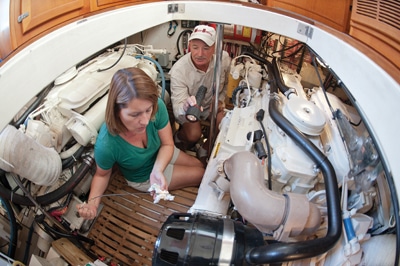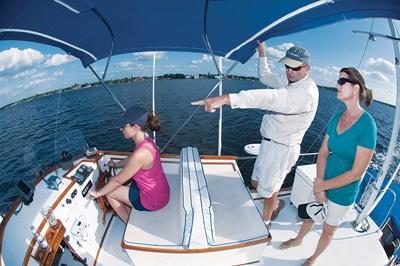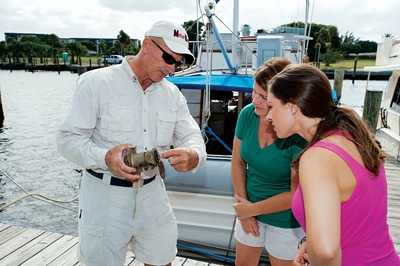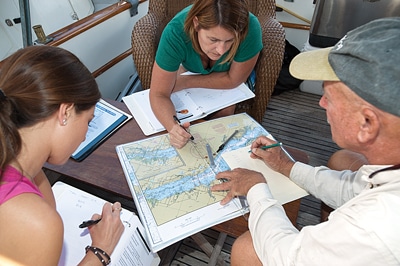When first asked to attend a boating school for a story in Boating, I felt cocky. I have been boating since I could walk. My dad gave me a 115 hp runabout at age 12. But decades later, when he offered me the helm of his trawler for a cruise, I suddenly realized how little lake boating had prepared me to handle a big cruiser.
So I e-mailed the staff at Florida Sailing & Cruising School, celebrating 30 years in business in Fort Myers, Florida. I entrusted them to help my niece Emily Campagna and me get schooled in long-range cruising. The school chose Precious, a single-engine Grand Banks 32, for us and assigned Capt. Chris Day, stiff-upper-lip Brit, to teach us.
Is boating school worth it for a lifelong boater? Spit out your gum, grab a seat and stop talking. Class is in session.
First Period: Shop
Day speaks like British CNN journalist Piers Morgan. Rather than spinning yarns or starting the engine, he lifted the hatches. My fantasy of salt air switched to bilge breath.
Recently, aboard my dad’s trawler, I’d pushed the kill switch. It didn’t kill. An hour later, after a call to my husband and the help of a neighbor, I found the fuel valve and shut it off. Bilge breath or not, I needed to learn.
Day is good. He soon had Emily and me debating the value of duplex fuel filters as we switched the fuel supply from one to the other while we changed an element. Day walked us through the boater’s checklist. Cloudy or milky bilge water could mean an oil or lubricant leak. Smell fuel? Check for leaks and don’t start the engine. Smell rubber burning? Shut it down and check the water pump impeller, or belts. Day drew diagrams for us as he went. They came in handy later, while we studied for our final exam. We also learned practical tips, like placing a disposable roasting pan lined with a dog pee pad under the engine so we could easily tell if a leak had occurred.
Hunger pulled us out of the bilge at noon. We quizzed Day more on engines between mouthfuls of sub sandwiches. His methodical approach made learning easy. Now, the marina flags were whipping. Great. Docking lessons were next.


Second Period: Docking Geometry
Day began to school us on how to disembark, or leave the dock. “One of you is the captain,” he said, “and the other does what the captain says. I offered to be captain.
“First rule is that the captain delegates tasks to each person — it may be the task of doing nothing at all. Otherwise chaos sets in. Never assume the crew knows what to do.”
The wind was blowing 15 to 20 miles an hour. I started paying more attention. Then it gusted to 30 mph.
Maybe I was hasty in volunteering.
I was amazed at how seamlessly leaving the dock was with only one person telling everyone else what to do. I put the Grand Banks in gear.
“Here we are,” said Day, directing me to idle down in front of some empty docks. Emily and I breathed sighs of relief. No performance anxiety from onlookers and no boats to break, save our own. Emily went first. Day coached.
“Take it in close,” he said.
“Look at the imaginary line running down the middle of the slip.
“Neutral. Turn the wheel upwind.
“Reverse. Idle speed.
“Forward a moment to adjust.
“Reverse aaaaannnd…neutral. You’re home!”
We each did it three times, improving each time.
Our confidence soared. We gloated all the way back to the marina, where, to our dismay, one of us had to put Precious back into the narrow slip. This time with boats on both sides, and an audience. Day coached me into position. I’d almost nailed it when a bit of overconfidence took over. Another good lesson: Do-overs are OK. I took her around again.
It wasn’t pretty, but we got her in.
Day left us with encouraging words and 14 pages of homework.

Third Period: History Lesson
Day two started with us touring the engine compartments of two more vessels, a 40 and 42 with twins.
“Where are the Racors?” Day sniffed in Londonese. “The seacocks? Manual fuel cutoff?”
It was another empowering day. I was now comfortable, with so much boating knowledge. But I was still struggling with docking. I lacked the confidence to back in alone. I lay awake all night doing it in my head, But I still couldn’t make it work on the water the next day.
I set it up. I began to back and got a break — no big gust. I was just about to clear the bow of the adjacent boat and …almost…lined…up to start backing her in. Emily prepared the lines, standing ready. Bam! A big gust pushed the stern to port. Capt. Day quietly called the shots. Everyone in the marina was watching — including the owner of the cruiser alongside. Then I had my epiphany. I got it! I started shifting and throttling before Day called for it. I greased her in. Emily made fast the lines.
The cruiser owner high-fived us and passersby flashed thumbs up. But we were soon brought back to earth. Tonight was our last night on the boat, and Day had left us a pile of homework to prepare for our finals tomorrow, including chart work.
“This is where we are going tomorrow,” said Day, jotting down latitude and longitude coordinates. “Plot a course to get us there.”
I’m doomed. I can’t even turn on the GPS in our boat.

Fourth Period: The Final Exam
At 5 a.m. we woke under a blanket of books and paper charts. I had dreamed charting problems all night, but we still hadn’t plotted our course. The temperature had dropped into the 40s and, oh joy, the wind was still up.
We had a destination, but only Emily had the confidence to work out the course on the charts. Capt. Day arrived and reviewed our work with approval. We prepared to depart. I took the role of captain again.
“Emily, at your leisure, please cast off the starboard line,” I commanded. She handled the lines expertly. We were off on our journey.
Heading out, all our discussions about markers and buoys came to life.
“Red right returning, unless you are headed to Texas?” Day joked.
I couldn’t imagine trying to run the Intracoastal Waterway without going to school first.
At a blind turn, I blew a short blast on the horn to notify any traffic we were coming. Emily enjoyed her victory in charting. Precious’ engine chugged us onward.
“Reduce your speed under a bridge” Day warned. “You never know if another boat will slip from behind the apron. But not too much. If there is a current, you need adequate steerage.”
“See that boat’s port bow? When he is crossing paths with you, he has the right of way.” He coached us on the basics as we cruised, and in context the instructions were easily remembered. Boating things are best learned by doing.
Day guided us toward an anchorage. We discussed how different types of anchors are used based on the size of the boat and the type of bottom. We used a Bruce anchor because it sets quickly and holds well in tide changes. He had taught us to come up with hand signals before a trip to ensure good communication between bridge and bow. On our trip, a raised fist meant “neutral.” It sure beat yelling through the windshield and over the wind.
Once anchored, Day handed us our test packets. We took our exams on the aft deck. It was a team test and open book. By this time, working together was something Emily and I were very good at. We missed only two questions on the entire test. We cruised back to port.
The Final Bell: Graduation Day
Back at our slip, Day started talking me through the steps and then stopped. He realized I was a split second ahead of him, handling the boat on my own. My initial cockiness was gone. As I was handed my diploma, I started thinking about a more advanced course. Boating school was fun.
Boat Schools
There are boat schools around the country. A sampling is listed below. And don’t forget that your local U.S. Power Squadrons or U.S. Coast Guard Auxiliary flotilla can be a great resource for safe boat-handling instruction.
Florida Sailing & Cruising School at Southwest Florida Yachts
Fort Myers, Florida
800-262-7939
flsailandcruiseschool.com
U.S. Powerboating based in Portsmouth, Rhode Island
This organization offers a variety of boat-handling courses at locations nationwide.
401-683-0800
uspowerboating.com
Shore Boating School
This New Jersey-based school offers a variety of boat-handling, safety and navigation courses.
908-461-0303
shoreboating.com








